In Part II, we chronicled the Fiat story to the death of Giovanni Agnelli shortly after WWII. This week, we continue with the reign of Vittorio Valetta, from 1945 to 1966.
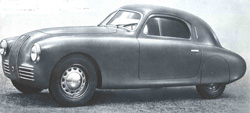
If the 1100s looks familiar, it is because a number of them
were raced in early U.S. road races in the early 1950s.
|
The era of Vittorio Valetta, 1946-1966.
The death of Giovanni Agnelli on December 16th, 1945 created a crisis in the company. His grandson, Giovanni, better known as "Gianni", was not particularly interested in running a huge firm. In 1946, Vittorio Valetta met with the 24 year-old Agnelli and reportedly said something to the effect of "Someone has got to run this company. Either it is going to be me or you. You decide." The young playboy chose to take his grandfatherís advice to do plenty of running around before he took control of Fiat. While young Gianni fiddled, Valetta proceeded to make Fiat a domineering giant, and made Turin almost as important as Rome.
Post War Fiats
The 500, the six cylinder 1500 introduced in 1935, and the 1100, having survived the war, were continued with minor changes. For enthusiasts, the two most significant cars of the immediate postwar era were the 1100S of which 401 were made. A good number of these made it to the U.S. The later 1100SE with a heavier Pininfarina body was less powerful version.
Shell type bearings were used on the 1100s from this time forward.
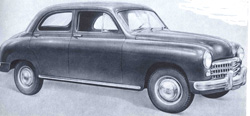
Chubby, landmark car from Fiat. The 1400 was the first unit bodied Fiat
and heralded a new way of production techniques.
|
Given a healthy dose of Marshall Plan dollars, Valletta put his engineers to work on the first new post war car, the unit frame 1400, introduced in 1950. From then on all Fiats would use a unitary construction. The 1400, as dowdy as it may seem today, was a landmark car for Fiat, and the basic design lingered on for almost 10 years, in diesel and 1900 cc versions.
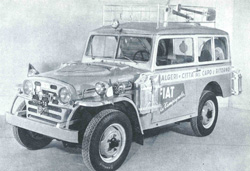
The Jeep-like Fiat Campagnola was ahead of it's time. It was sriven from Capetown S. Africa to Algeria in 11 days, four hours and 54 minutes, establishing a record.
|
Experiments and Oddities
Far too early for the SUV generation was the Campagnolo "Jeep" in 1951, a 1900 cc four with four wheel drive, which could be engaged to the drive all four or just the rear two wheels.
One of the most prized Fiats of all time was launched in 1951, the Otto Vu.
114 were made, mostly with a Fiat styled body in steel. The first Fiat with both front and rear independent suspension, it also featured a unique 1996cc V8 engine, capable of 105 hp at 6000 rpm.>p>
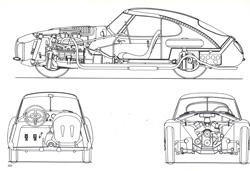
Otto Vum Italian for V-8, was a striking if somewhat ineffective classic-to -be.
|
A second engine variant produced 127 hp at 6600 rpm. While sought after today, the Otto Vu never sold well, nor did it bring home much silverware from the track. The engine, however, were also used in the Siata 208, which performed much better.
1953 was another year of change for Fiat. The pre-war 1100 was replaced by the "Nuovo" 1100, another long lived design, and of course had unitized construction.
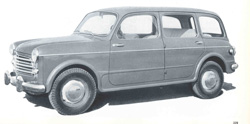
A rare veiw of the 1100 Station Wagon of 1953. Unit chassis with the OHV four, it produced 36 hp.
|
Coachbuilders must have found the new body frame configuration dastardly to modify, but eventually, they too, found ways around the problem. The sporting version was the "TV" for Touring Veloce, and along with the boxy sedan was a new sportscar version, looking decidedly American.
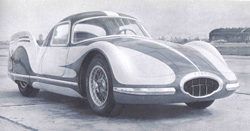
Turbina, a test bed exercise to see if the gas turbine was suitable for the
motor car. It wasn't but it looked great.
|
Rover did it, Chrysler did it, even Andy Granatelli did it, and in 1954 Fiat experimented with a turbine engined car which looked fantastic but like all the other turbine cars failed to prove much. Only one was made, with a drag coefficient of only 0.14.
An about face
In addition to having a hand in most of Fiatís post war engine designs, Dante Giacosa was also hyping rear engine solutions to a very conservative company. Giacosaís career was at risk. As he later recalled, "What terror! "I knew that investments for millions and millions were at stake." But the 600 of 1955 was indeed a success, following the pattern set by Renault and Volkswagen, the engine was set behind the rear wheels, which left plenty of room for the passengers at the cost of being a bit tricky to drive. Despite the physics, the rear engined concept would survive until the introduction of the front drive 128 in 1969.
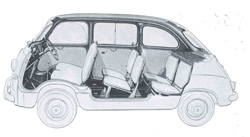
The 600 Multipla, in cutaway drawing. The Multipla was offered in three versions, a taxi, a 4-5 seater and a 6 seater.
|
Speaking of room, Fiat did VW Microbus one better with the 600 derived Multipla, a car surely ahead of itís time. Possibly one who took notice was one Lee Iaccoca.
If the concept worked for the 600, Giacosa figured it would work even better for a completely new Topolino, and in 1957 the rear engined 500 made itís debut. It didnít catch on immediately. With a air cooled twin of 479cc it put out only 13 hp at a mighty 4000 rpm.
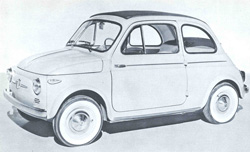
Today's cult car, the 500,was a practical solution for the narrow medieval roads of Italy in the 1950s.
|
This was raised to 21 hp in 1958, and to 22 hp for the later D and F versions of the mid to late 60s. Eventually, it became, as it is today, a cult classic, far surpassing the standard 600 in legend and desirability. The 500, 600 and 1100 had "suicide" doors until the early 60s, making the earlier versions of each more dangerous and paradoxically, more valuable today.
The Impulse of the Italian Miracle
The coachbuilders were a little happier with the 600, as it offered what could be called a platform chassis which allowed firms like Zagato to build up a special body with small tubes supporting the aluminum body.
With the help of Zagato, Allemano and others, Abarth took the 600 and 500 to new heights, all the while being supported by the Fiat company. Carlo Abarth was not alone, however.
The number of people who lived off the largess of Fiat, either indirectly or directly, was enormous. By the mid-60s, Fiat employed 130,000 people, while over 500,000 were indirectly dependent upon the automaker. In Turin, thousands of Italians from the southern half of the country came to work for Fiat, and the lack of planning and foresight, not to mention social services, was to help create the tremendous laboróand social problems of the 1970s.
But in the sixties, the miracle went on.
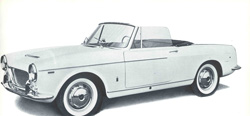
The 1200 Cabriolet was to see a number of variations, the best being the 1600S OSCA engined model. Quality was as high as the Alfas of the era.
|
One of the nicest, if ladylike, Fiat sports cars ever was the 1200 Cabriolet, which saw daylight in 1959 and continued in 1500 and 1600 forms until 1966. The same design was also powered by an engine created by the brothers Maserati, with a true DOHC design. Designated the Fiat 1500S and 1600S, the Fiat OSCAs are among the most sought after Fiats of the Valetta era.
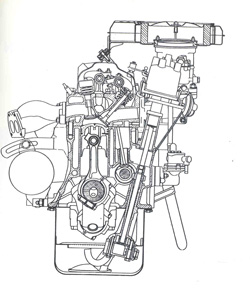
Finally an engine that could breathe. Aurelio Lampredi assisted Giacosa with the design. The
1500 four cylinder introduced in 1961 and produced 83 hp in final form.
|
In 1959 Fiat, took another look at the large car market again produced a six cylinder, the 1800 and 2100 sedans and station wagons. The engine was "modern", with inclined overhead valves and a cross flow head. A similar cross flow four cylinder of 1300 and 1500 cc was produced in 1961 to power a new series of front engined sedans. What is striking, is that Fiat declined to utilize overhead cam and cross flow head technology, until the 1960s, even though they employed a DOHC design with the 1921 801-401 Grand Prix car. And when the did eventually bring back the full DOHC, Fiat let OSCA do it for them.
The large Fiats were on a par with the bigger Alfas and Lancias, but lacked the prestige of the smaller companies. The 2300, an upgrade of the 2100, was used in an attractive Ghia coupe, but found little success, despite efforts by Abarth and Allemano.
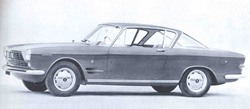
A pleasant, if large sports coupe, the 2300 was the high end Fiat in the early 1960s. Abarth offered 2200 and 2400 versions with bodies by Allemano
|
The reign of Vittorio Valetta and Dante Giacosa was coming to a close. In 1966, Valetta turned over the company to Giovanni "Gianni" Agnelli, and Giacosa retired in 1970. In 1945, Fiat was producing 3,260 cars a year. By 1966, Fiat was building that many per day while sales were $1.5 billion per year. It was the Italian Miracle personified.



